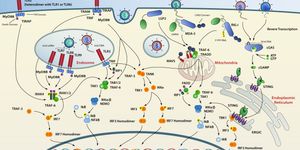Chemical Cues May Have Enabled the Rise of Multicellularity
New research has suggested that Earth's first animal probably used chemical signals to grow from one cell into an organism composed of multiple cells. Single-celled organisms can usually clump together into colonies, and chemical signals control that clumping in some animals and single-celled microbes. In a new study, scientists investigated the properties of an organism called Capsaspora owczarzaki, a unicellular microbe that is known to be a very close relative of animals. This work showed that chemical cues involving calcium ions and lipids found in lipoproteins can trigger Capsaspora cells to aggregate, and this process is reversible.The aggregation of these cells can be seen in the video below.
The findings have been reported in the Proceedings of the National Academy of Sciences (PNAS).
"The general view is that animals evolved from a unicellular organism, and this research helps explain how that may have happened and how those cells chose whether to be together or on their own," said study co-leader J.P. Gerdt, an assistant professor of chemistry at the Indiana University Bloomington College of Arts and Sciences. "Our results help us understand more about the first animals and their ancestors."
All multicellular animals are grouped within Metazoa. The Holozoa clade contains Metazoa along with their closest unicellular relatives, which include Capsaspora. A comparison of the genomes of animals and unicellular holozoans has shown that many unicellular holozoans encode genes that are very similar to the ones that are required for the development and multicellular nature of animals. The multicellular aggregates generated by Capsaspora are similar to those that can be found in sponges or hydra.
In this study, the researchers simply exposed Capsaspora to various chemicals as they grew in a liquid media. This work showed that increasing levels of lipoproteins that included calcium ions and lipids encouraged the cells to clump together, and decreasing the level of lipoproteins caused the clumps to separate.
The researchers suggested that this process mimics the transition from single-celled organisms to multicellular organisms that occurred in nature, and that we now have more insight into how animals' ancestors might have made the jump with chemical cues.
Microbes use chemical signals to communicate with one another, and these signals might encourage cooperation or competition. If we learn more about these signals and how they affect microorganisms, we may one day be able to use them to control pathogenic microbes, including those that infect humans.
Sources: Indiana University, Proceedings of the National Academy of Sciences (PNAS)









